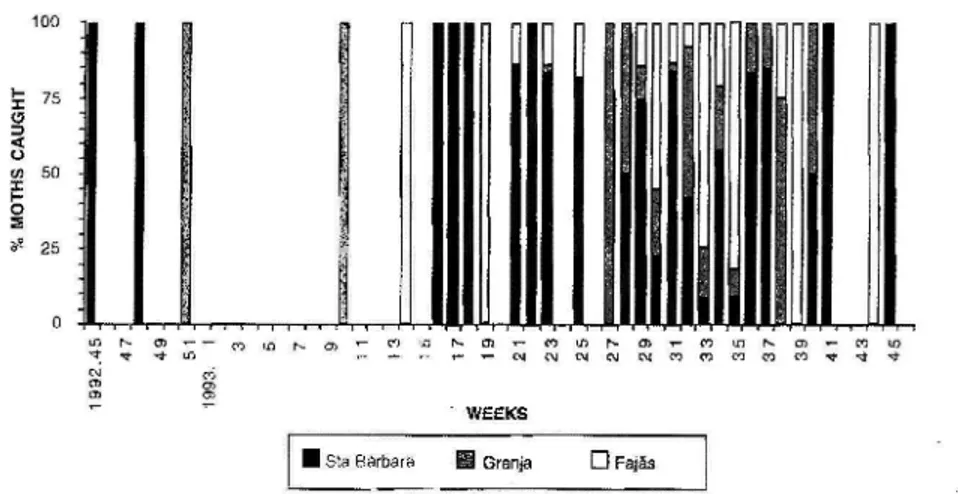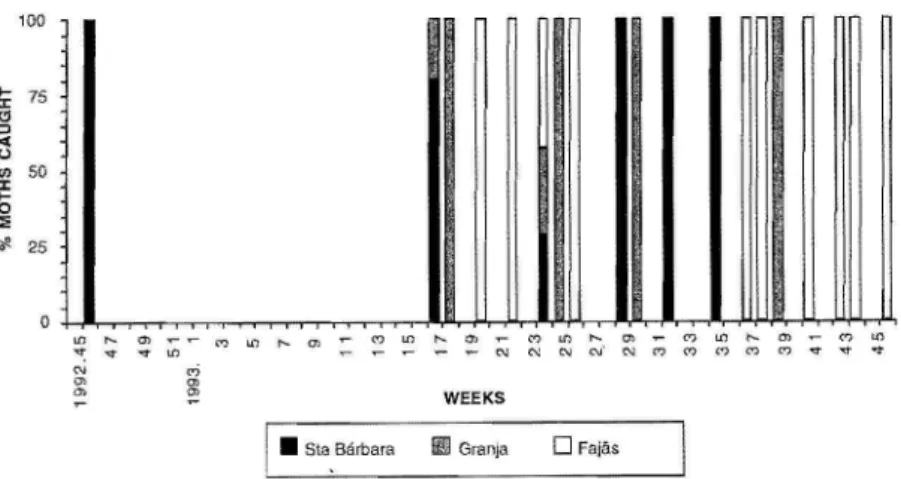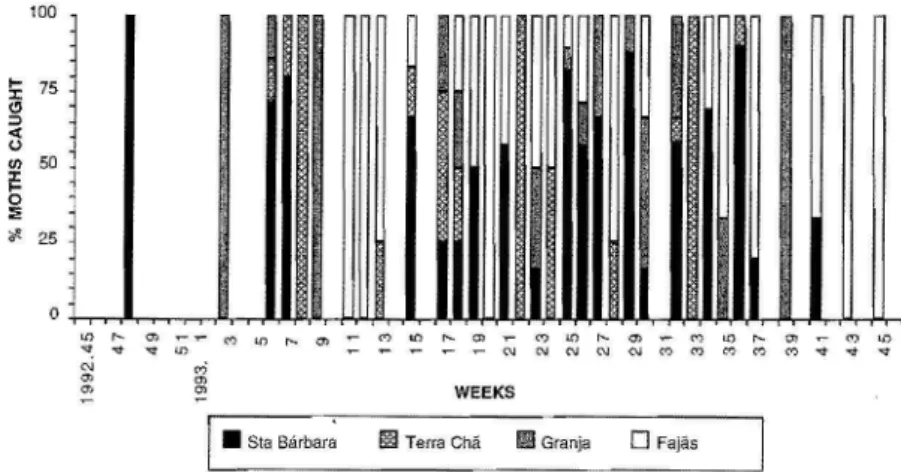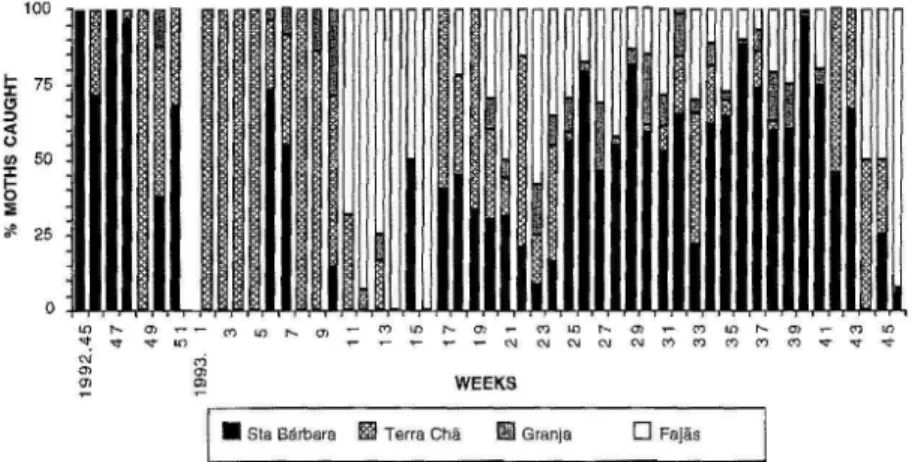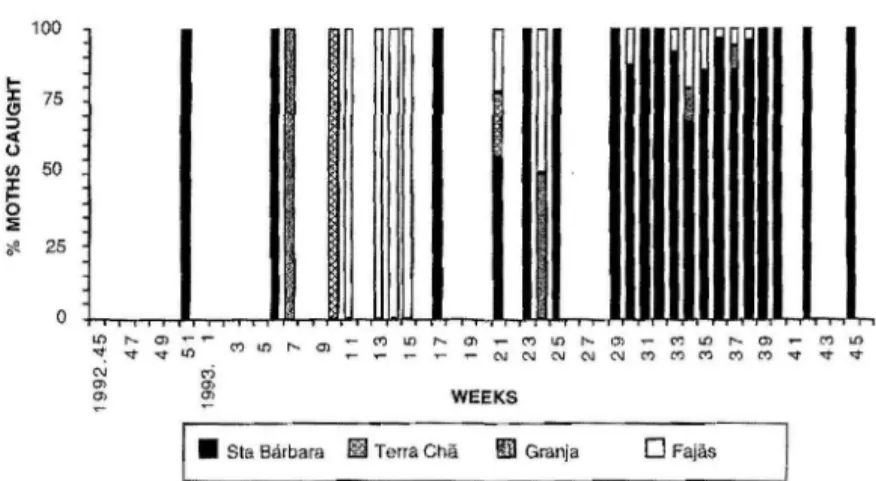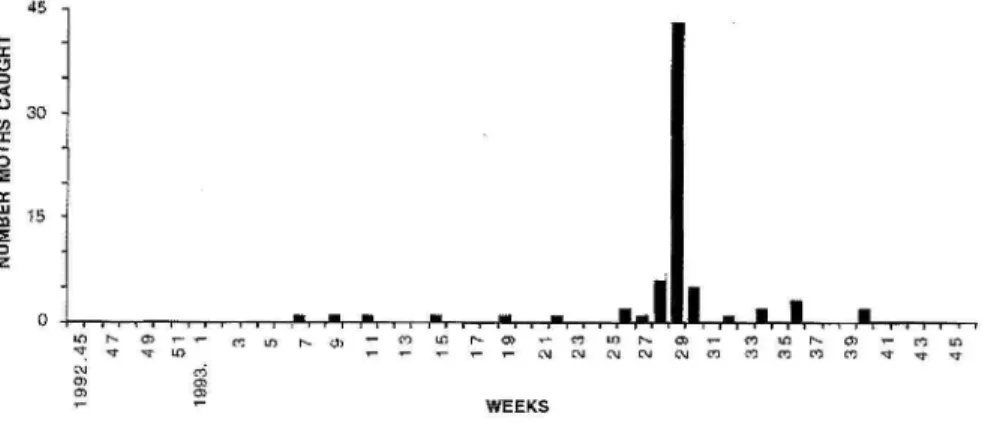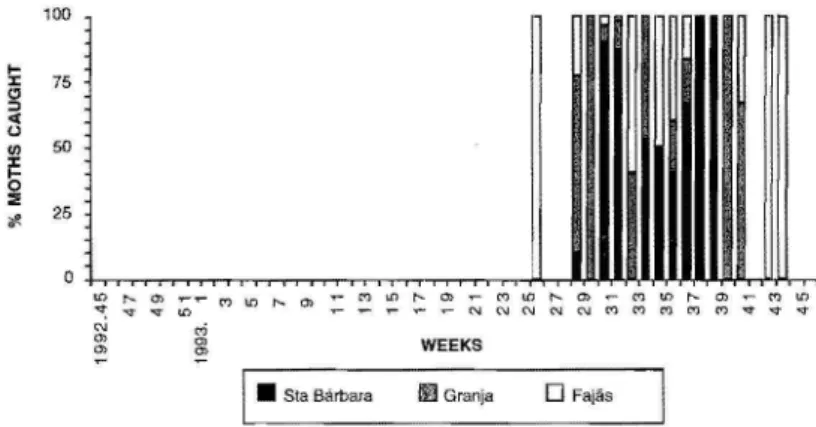SEASONAL DISTRIBUTION AND SEX RA TIO OF ELEVEN NOCTUID SPECIES (INSECTA, LEPIDOPTERA) CAPTURED lN BLACKLIGHT
TRAPS ON TERCEIRA ISLAND (AZORES)
By V. VIEIRA 1, M.G. GOMES DE ARAÚJO 2 & J. TAVARES I
With 11 figures and 1 table
ABSTRACT. The adu/t f1ight periods of Agrotis segetum (DENNIS & SCHIFFERMÜLLER), Noctua pronuba (LINNAEUS), Noctua atlantica (W ARREN), Peridroma saucia (HÜBNER), Xestia c-nigrum (LINNAEUS), Mythimna loreyi (DUPONCHEL), Phlogophora meticulosa (LINNAEUS), Phlogophora interrupta (WARREN), Mesapamea storai (REBEL), Autographa gamma (LINNAEUS), and Trichoplusia orichalcea (FABRICIUS) (Lepidoptera: Noctuidae) were studied between November 1992 and November 1993, at Terra Chã (lI O m), Granja (310m), Fajãs (310m) and Santa Bárbara (525 m) on the island of Terceira, Azores archipelago, using Pennsylvania blacklight traps. While there was evidence of considerable fluctuations in abundance, A. segetum, P. saucia, X c-nigrum, M loreyi and P. meticulosa were present continuously at Santa Bárbara. ln contrast N. pronuba, N. atlantica, M storai, P. interrupta, A. gamma, and T. orichalcea were generally captured from Spring to beginning of Autumn. For any given species both sexes were captured simultaneously. Males of X c-nigr1Jm, P. meticulosa (Santa Bárbara), A. segetum and M storai (Fajãs) were more frequent than females, while in the other species females were more abundant. However, in no case does the sex ratio deviates entirely from I: I. Under an integrated pest management perspective, blacklight trap is an important technique for agricultural warning services, allowing to forecast the outbreaks of agricultural pests.
I Universidade dos Açores, Departamento de Biologia, PT - 9500 PONTA DELGADA (Açores). 2 Quinta da Piedade, Lote 45, 3° FRT, PT - 2625 Póvoa de Santa Iria.
496 Boletim do Museu Municipal do Funchal (História Natural) Sup.no.S
INTRODUCTION
Terceira island, Archipelago of the Açores, located in the Atlantic ocean between 38°38'10" and 38°47'40"N and between 27°03'00" and 27°24'00"W, presents c1imatic conditions favorable for the development of many Lepidoptera (about 106, VIEIRA, 1997), including some species of Noctuidae that are considered as agricultural pests (TA VARES, 1989). The adults of this family present great mobílity, and the larvae of many species are polyphagous. The migratory movements of certain noxious species stresses the need for a waming system that alIows to forecast their outbreaks. For what, among other techniques, Iight traps are used (VIEIRA et aI., 1994).
ln Terceira island the following noctuids were frequent1y captured by this sampling method: Agrotís segetum (DENNIS & SCHIFFERMÜLLER), Noctua pronuba (LINNAEUS), Noctua atlantica (W ARREN), Peridroma saucia (HÜBNER), Xestia c-nigrum (LINNAEUS), Mythimna loreyi (DUPONCHEL), Phlogophora meticulosa (LINNAEUS), Phlogophora interrupta (WARREN), Mesapamea storai (REBEL), Autographa gamma (LJ:NNAEUS), and Trichoplusia orichalcea (F ABRICIUS) (Lepidoptera, Noctuidae).
A. segetum, N. pronuba, N. atlantica, P. saucia, andX c-nigrum bel ong to subfamily Noctuinae. With the exception of N. atlantica which is endemic (WARREN, 1905; MEYER, 1991; VIEIRA & PINTUREAU, 1993), they are considered as agricultural pests, with a cosmopolitan distribution (BALACHOWSKY, 1972; TAVARES, 1989). They are reported for alI the Azorean Arquipelago, except A. segetum which has not been recorded for Pico and Faial, N. atlantica for Santa Maria and N. pronuba not found in Graciosa (VIEIRA & PINTUREAU, 1993; VIEIRA & TAVARES, 1995; VIEIRA, 1997).
M loreyi (subfamily Hadeninae), with a tropical-subtropical origin, is only recorded for Graciosa, Santa Maria and São Miguel islands (VIEIRA & PINTUREAU, 1993; VIEIRA, 1997).
A. gamma and T. orichalcea(subfamily Plusiinae) may present several generations per year and both arc widely polyphagic species, with a palearctic and tropical-subtropical distribution, respectively (BALACHOWSKY, 1972; CALLE, 1982). They are reported for alI the Azorean Arquipelago (VIEIRA & PINTUREAU, 1993; VIEIRA & TAVARES, 1995; VIEIRA, 1997).
M storai, P. interrupta and P. meticulosa belong to subfamily Ipimorphinae. P. meticulosa can present several generations per year and is a widely polyphagic species, with an asiatic-mediterranean distribution (BALACHOWSKY, 1972; CALLE, 1982). The three species are reported for alI the islands ofthe Azorean Arquipelago, except M storai which is not recorded for Santa Maria and Graciosa, and P. interrupta an endemic species (MEYER, 1991; VIEIRA & PINTUREAU, 1993) not found in Graciosa and Corvo (VIEIRA & PINTUREAU, 1993; VIEIRA & TAVARES, 1995; VIEIRA, 1997).
ln this paper, seasonal distribution and sex ratio was studied for the above mentioned noctuid species. The potential impact of these species on the regional agroecosystem is also discussed.
1998 Proceedíngs ofthe "2"" Symposium Fauna & Flora ofthe Atlantic Islands" 497
MATERIAL AND METHODS
The adult flight periods of A. segetum, N. pronuba, N. atlantica, P. saucia, X c-nigrum, M loreyi, P. meticulosa, P. interrupta, M storaí, A. gamma, and T. orichalcea were studied using pennsylvania light traps placed at four locations in Terceira island: Terra Chã (110 m), Granja (310 m), Santa Bárbara (525 m) (from November 1992 to November 1993; 53 weeks), and Fajãs (310 m) (between March and November 1993; 36 weeks). For a given species, stations where the number of aduIts was very low
«
3 aduIts) are not discussed here.Following SILVA et ai. (1995a), each Iighttrap, equipped witha TLD 18W lightbulb, was Placed lifted at the hedge of a permanent graminae pasture, one meter above the ground. The captured specimens would fali into a container with a formalin solution (5%). Adults were collected from trap-containers once a week. The biological material was washed, and sorted by species and sexo Records were made of species name, sex and date of capture for each specimen. The number of captured adults per week for each species and location was determined.
ln order to evaluate differences between male and female catches at the sarne place, and between places, data were arcsine transformed prior to applying two factor analysis of variance. Differences in total catches between sites were analysed using a log(x+ 1) transformation followed by a one-way analysis ofvariance and Scheffe test when appropriate.
RESUL TS AND DISCUSSION
Agrotis segetum (DENNlS & SCHIFFERMÜLLER)
The total catches of A. segetum were 239 adults at Santa Bárbara, 34 at Granja and 74 at Fajãs (Fig. 1, Table 1). This species was more abundant in Spring and Summer; it appeared sporadically in March and November-December at the highest location (Santa Bárbara). The captures reached a maximum of 88 adults at Santa Bárbara in Summer 1993. The sex ratio was favourable to the females at Santa Bárbara (54.81%) and Granja (58.82%), while at Fajãs it was so for the males (44.59%) (Table 1).
Since A. segetum is considered a sedentary species (POITOUT & BUES, 1976), this sex ratio variation might be related to the higher number ofinsects captured at higher altitude, which probably results from favourable c1imatic conditions for insect development (SILVA et ai., 1995a).
No significant differences were found betwç-en places (F=0.2, p=0.854) or between the sexes (F=l.O, p=0.323). Also, the interaction between both factors is not significant (F=O.5, p=O.584).
According to SILVA et ai. (1995a), A. segetum is markedly polyphagous, attacking many ofthe crop plants and weeds in the region, except for flowers and garden plants.
498 Boletim do Museu Municipal do Funchal (História Natural) Sup.no.5 100
~llr
;-75 J: (!I => ..: u'"
50 j!;1111
O :;; 1J'. 251111111
.,...-. ,...., WEEKSI_
Sla Bárbara !!!! Granjao
FalásFig. 1 Proportion of A. segetum adults captured weekly atthree sites in Terceira island: Granja, Santa
Bárbara (uom November 1992 to November 1993; 53 weeks), and Fajãs (between March and November 1993; 36weeks).
Noctua pronuba (LlNNAEUS)
The total catches of N. pronuba were 30 at Santa Bárbara and 13 at Fajãs and Granja (Fig. 2, Table 1). This specíes was observed mainly in the second semester of 1993, with a maximum of captures between July and September, and at higher altitude.
100 ;-75 J: (!I => ..: u
'"
50 i J: ;-o :;; 1f. 25 "" '" ~ '" '" "-'"
~ ....'"
~ '" <fl ""'"
~'"
UJ""
'" :;;'"
U1""
..
'" ~ ~'"
'" '" '" N '"'"
'" '" '" ..,..,.
oi '" ;::: WEEKS, _ Sla Bárbara II Granja O Fajás
Fig. 2 - Proportion of N. pronuba adults captured weekly at three sites in Terceira island: Granja,
Santa Bárbara (from'November 1992 to November 1993; 53 weeks), and Fajãs (between March and November 1993; 36 weeks).
1998 Proceedings ofthe "2nd Symposium Fauna & Flora ofthe Atlantic Islands" 499
The sex ratio was favourable to the females at Fajãs (53.85%) and Granja (76.92%), while for Santa Bárbara it was 50% (Table I).
No significant differences were found between places .6, p=O.212) or between the sexes (F=OA, p=0.504). AIso, the interaction between both factors is not significant (F=OA, p=O.688).
N pronuba attacks many plants, mainly horticultural crops and weeds (SILVA et aI., 1995a). Noctua atlantica (W ARREN)
The presence of N. at/antica, an endemic species of the Azores, was nearly constant in the three locations (Fig. 3, Table 1), except during the Winter, with a total of 27 at Santa Bárbara, 18 at Fajãs and 11 at Granja. The highest catch was 16 adults, in August 1993 at Santa Bárbara. 100 I- 75 :r (!) :::l <I( <..l
'"
50 :r I-o :; # 25 WEEKS M ~ ~ rn _ M ~ ~ m ~ ~ ~ N N ~ ~ ~ M M M M ~ ~ ~I • sta, Bárbara li!!I Granja D Fajás
Fig. 3 Proportion of N. atlantica adults captured weekly at three sites in Terceira island: Granja,
Santa Bárbara (from November 1992 to November 1993; 53 weeks), and Fajãs (between March and November 1993; 36 weeks).
The sex ratio was favourable to females in ali the studied locations: Santa Bárbara and Fajãs 66.67%, Granja 63.64% (Table 1).
No significant differences were found bctween places (F=1.7; p=O.l82) or between the sexes (F=OA, p=0.554). AIso, the interactíon between both factors is not significant (F=OA, p=O.64 1).
Peridroma saucia (HÜBNER)
The presence of P. saucia was nearly constant in the four locatíons (Fig. 4, Table 1), with a total of 127 adults captured at Santa Bárbara, 52 at Fajãs, 27 at Granja and 14 at Terra
500 Boletim do Museu Municipal do Funchal (História Natural) Sup.no.5
Chã. The highest catch was 44 adults, in August 1993 at Santa Bárbara, but was much 10wer at the other sites.
Regarding the species as a migrant (POITOUT & BUES, 1976), this peak can be
related to the capture of adults arriving from other locations, eventually of 10wer altitudes,
and normaly with higher temperature (SILVA et aI., 1995a).
The sex ratio was favourable to females in ali the studied locations (Santa Bárbara 60.63%, Fajãs 53.85%, Granja 55.56% and Terra Chã 78.57%) (Table I).
Significant differences between places (F=6.3, p=0.0004) were found between Santa Bárbara and Terra Chã, and between Fajãs and those of Terra Chã and Granja (p<0.05), but no significant differences were found between sexes (F=l.l, p=0.058). The interaction
between factors was also not significant (F = 0.3, p = 0.843).
P. saucia can damage different crops, except flower crops, and garden and forestry
species (SILVA et ai., 1995a).
100 I- 75 :t: (!! ::> <I: o UJ 50 :t: I-o :; ." 25 o r- Ol
""
UJr-'"
~'" '"
r- O> ~'"
U')r-'"
~ '"'"
r- '" :;;:'"
l i )" "
UJ ~ ~ ~ ~ '"'"
'" '" OJ '"'" '"
'""
" <'i Ol ~ WEEKSFig. 4 - Proportion of P. saucia adults captureq weekly at four sites in Terceira island: Terra Chã,
Granja, Santa Bárbara (from November 1992 to November 1993; 53 weeks), and Fajãs (between March and November 1993; 36 weeks).
Xestia c-nigrum (LINNAEUS)
The total catches of
x:
c-nigrum were 1022 at Santa Bárbara, 316 at Fajãs, 124 atGranja and 171 at Terra Chã (Fig. 5, Table I). The species was nearly allways present at the four locations, with the maxima of 147 and 127 adultes at Santa Bárbara, during the Summer months.
The sex ratio was not favourable to females at Santa Bárbara (47.75%), Granja (37.9%) and Terra Chã (39.18%), while at Fajãs it was so for the males (47.78%) (Table I). Significant differences in captures (F=12.46, p<O.OOOI) were found between Santa
1998 Proceedings of the "2"'i Symposium Fauna' & Flora of the Atlantic Islands" 501
Bárbara and those of Terra Chã and Granja, and between Fajãs and those ofTerra Chã and Granja (p<0.05), but no significant differences were found between sexes (F=0.3, p=0.563). The interaction between factors was also not significant (F=O.I, p=0.969).
ln the Azores, X c-nigrum feeds on a great variety of cultivated plants, except for
those used in forestry (SILVA et aI., 1995a).
100 li: 75 Cl :> <C (.)
'"
50 :c b :ii '# 25 o t- a>'" '"
t- O'> -'"
'" t- O>-'"
'" l"- O'> ;;'"
'" t- a> '" '"..
v "'-
-
-
-
-
N N N N N '" '" M '"...
.". v ..;""
WEEKS e'[ • Sla Bárbara !ii!! Terra Chã mil Granja
o
FalãsFig. 5 Proportion of X c-nigrum adults captured weekly at four sites in Terceira island: Terra Chã, Granja, Santa Bárbara (from November 1992 to November 1993; 53 weeks), and Fajãs (between March and November 1993; 36 weeks).
Mythimna loreyi (DuPONCHEL)
The total numbers of M loreyi adults captured in the light traps (Fig. 6, Table 1)
were 2687 at Santa Bárbara, 121 at Fajãs, 36 at Granja and 3 at Terra Chã. The species was nearly aIlways present in the Summer and Autumn months at the three locations, with the maximum catches of762, 428, 368 and 23'7 adults at Santa Bárbara (higher altitude), during the Summer months.
The sex-ratio was favourable to females at Santa Bárbara (55.53%) and Granja (55.56%), white it was so for the males at Fajãs (50.41%) and Terra Chã (100%) (Table 1). Significant differences were found between places (F=I1.57, p<O.OOOl), mainly between Santa Bárbara and Terra Chã or Granja, and between Fajãs and Terra Chã (p<0.05), but no differences were found between sexes (F=O.2, p=O.670). Also, the interaction between factors was not significant ( F=O.2, p=0.922).
The larvae is polyphagous and feeds on a great variety of cultivated plants, namely Poaceae.
S02 Boletim do Museu Municipal do Funchal (História Natural) Sup.no. S 100 I-:r 75 (!) ;:) « O <I> 50 ~ O :;; <f. 25 O .... O> ~~
'"
'"
.... O>-
'"'"
.... a> ~'"
'"
.... a> ~'"
'"
.... O>-'" -'"
"
"
'" ~ -'" N'"
N '"'" '" '"
'"
'"
.,.
"
...
M cn ~ WEEKS, _ Sra Bárbara lil!J Terra Chã 1m Granja
DFajãs~
Fig. 6 - Proportion of M loreyi adults captured weekly at four sites in Terceira island: Terra Chã, Granja, Santa Bárbara (from N ovem ber 1992 to Novem ber 1993; S3 weeks) and Fajãs (between March and November 1993; 36 weeks).
Phlogophora meticulosa (LINNAEUS)
The total numbers of P. meticulosa adults captured in the light traps (Fig. 7, Table
1) were relatively low, i.e. 161 adults at Santa Bárbara and 46 at Fajãs. This species was
present during the whole year at Santa Bárbara, the higher numbers being recorded during
Summer months. A maximum of24 adults appeared at Santa Bárbara. At Fajãs the captures
revealed numbers lower than 10 insects. 100 !i: 75 CI :> « u (/) 50
~
:! .... 25 , _ SI. Bárbara O Fajõ.Fig. 7 - Proportion of P. meticulosa adults captured weekly at two sites in Terceira island: Santa Bárbara (from November 1992 to November 1993; 53 weeks) and Fajãs (between March and November
1998 Proceedings of lhe "2"" Symposium Fauna & Flora of the Atlantic Islands" 503
The sex ratio was favourable to males at both sites (Santa Bárbara 63.98% and Fajãs 62.5%) (Table 1).
The number of adults of P. meticulosa, although being rather low, shows no differences between places at high and medium altitudes (F=2.96, p=O.0892). This species shows a wide polyphagy, damaging many vegetable, industrial, fruit, flower, and cereal crops, as weIl as oak (SILVA et ai., 1994). We can find a relationship between some crops, growing at high altitude localities, and the appearance of adults. Although larval nocivity is not important (BALACHOWSKY, 1972), the relative abundance in its flight curve,joined to the polyphagy, lead to concero about local damage (SILVA et ai., 1994).
Phlogophora interrupta (W ARREN)
The total number of P. ínterrupta adults captured in the light traps at Santa Bárbara was 73 (Fig. 8, Table I), where the species was nearly allways present, except in Winter, with a maximum of 18 adults by the end of July 1993.
The sex ratio was favourable to females (58.9%) (Table 1).
Its presence is more characteristic in the natural forest, specially ofthe central group of the Azorean Archipelago (MEYER, 1991). The number of adults of P. interrupta being very low at lower altitudes (ARAÚJO, 1994).
18
ffi
16 ~ 14 U '" 12g
10 :;; tI:. lU til 6 :;; i 4 2r-.. O>"-T"" M lO f'-. Ç} ltl r... Q) .,.. C') Ln t- O'} ...- C"J l,.') t'-.. O> r - C') li)
~~U') . . . , . . . . Ç \ l N N C \ I < . ' \ J M { t ) C ' : l C ' ) ( ' I ) ' I t " : t ' < : t WE:EKS
Fig. 8 - Number of P. interrupta adults caplured weekly ai Santa Bárbara, in Terceira island, from November 1992 lo November 1993 (53 weeks).
Mesapamea storai (REBEL)
During the studied period, M storaí only appeared at Santa Bárbara and Fajãs (Fig. 9, Table 1), with a maximum of 18 captured adults by the end ofSeptember 1993.
504 Boletim do Museu Municipal do Funchal (História Natural) Sup.no.5
50% (Table 1).
The number of adults of M storai, although being rather low, shows no differences
between places at high and medium altitudes (F=1.66, p=O.2011). Its presence is more characteristic in the natural forest, specially in the central group of the Azorean Archipelago (MEYER, 1991). Moreover, it shows a preference for Poaceae, and probably its small variety ofprefered host plants is thereason for such a low frequence, as well as an indicator oflittle economic importance (SILVA et aI., 1994).
o "' .... '" <')
"'
r-'"
~ '" ti) r- '" ~ '" "' .... '" ;; '""'
r-"
::;: <') '" .". ,,- .". ti) ~ ~ ~'"
'" OJ N N '"'"
'" '" .". "" OJ M'"
'"
WEEKS ~ ;:"~
SI. Bárbara O FajãsFig. 9 - Proportion of M storai adults captured weekly at two sites in Terceira island: Santa Bárbara (froin November 1992 to November 1993; 53 weeks) and Fajãs (between March and November 1993; 36 weeks). 45
...
:r: (.') ::> « o 30'"
:r:...
o ::;: a:: UJ 15 Dl :ii' ::> zr-'"
'" '"r-'"
-
'"
"'
r-'"
-
'"
ti)r-'"
-
'" '" ....'"
~ '""'
.". ""'
~-
~ N N '" N N '" '" '"'"
'" " ..-oi'"
;:: WEEKSFig. 10 - Number of A. gamma adults captured weekly at Santa Bárbara, in Terceira island, from November 1992 to November 1993 (53 weeks).
1998 Proceedings ofthe "2'" Symposium Fauna & Flora ofthe Atlantic Islands" 505
Autographa gamma (LINNAEUS)
The total number of A. gamma adults captured in the light traps (Fig. 10, Table 1) was relatively low, Le. 71 adults at Santa Bárbara. Whatever the location, this species was present, except from November to January. The captures reached a maximum of 43 adults in July 1993.
The sex ratio was favourable to females in this 10cation (63.38%) (Table 1). A. gamma can find a large variety of plants available alI over the year at this locality. This suports its life cyde and may justify its abundance throughout the year, although in rather 10w numbers (SILVA et ai., 1995b).
Trichoplusia orichalcea (F ABRIClUS)
T. orichalcea WJls registered at the three places (Figure 11, Table 1), with a total of 167 adults captured at Santa Bárbara, 56 at Granja and 27 at Fajãs. This species was more abundant in Summer and Autumn months in alI three locations, with a peak of 75 insects in August 1993 at Santa Bárbara.
For this specics both sexes were captured simultaneously. The sex ratio was favourable to the females at Santa Bárbara (62.28%) and Fajãs (77.78%), and at Granja it was 50% (Table 1).
No significant differences were found between places (F=O.5, p = 0.588) or bctween the sexes (F=0.04, p=0.825). AIso, the interaction between both factors was not significant (F=O.5, p 0.615).
SILVA et aI. (1995b) showed that T. orichalcea is polyphagous, artacking many vegetable crops planted in the Azorean islands.
...
:c (!l :::. « (.) <Il~
:! # 100 75 50 25 ~ M ~ ~ m ~ M ~ ~ m ~ M ~ ~ m ~ M ~ ~ ~ ~ N ~ N N N M M 00 M M ~ ~ ~Fig. 11 - Proportion of T orichalcea adults captured weekly at three sites in Terceira island: Granja, Santa Bárbara (from November 1992 to November 1993; 53 weeks), and Fajãs (between March and November 1993; 36 weeks).
506 Boletim do Museu Municipal do Funchal (História Natural) Sup. no. 5
T ABLE 1 The total numbers of moths and percentage of females of A. segetum, N. pronuha, N.
atlantica, P.saucia, X c-nigrum, M loreyi, P. meticulosa, P. interrupta, M storai, A. gamma, and T.
orichalcea captured weekly in Terceira island at Terra Chã, Granja, Santa Bárbara (from November
1992 to November 1993; 53 weeks), and Fajãs (between March and November 1993; 36 weeks). LOCALfIY
SI"ECIES Sta Bárbara Fajãs Granja Terra Chã
(525m) (310 m) (310 m) (110 m) Agrotis segetum Total 239 74 34 Mean + Std. error 4.51 ± 1.95 2.06±0.68 0.64+0.18 % Females 54.81 44.59 58-:-82 Noctua pronuba Total 30 13 13
Mean + Std. error 0.57±0.18 0.36+0.14 0.25±O.10
% FemãJes 50 5Ú5 76.92
Noctua atlantica
Total 27 18 11
Mean + Std. error 0.51+0.32 0.50±O.16 0.21±0.09
"lo FemãJes 66-:67 66.67 63.64 Peridroma saucia Total 127 52 27 14 Mean + Std. error 2.4±0.95 1.4+0.27 0.5+0.16 0.26±0.07 % FemãJes 60.63 53.85 55.56 78.57 Xestia c-nigrum Total 1022 316 124 171 Mean + Std. error 19.3±4.24 8.8+ 1.40 2.3±0.61 3.2+0.45 % FeniãIes 47.75 52.22 37.9 39.18 Mythimna loreyi Total 2687 121 36 3 Mean + Std. error 50.7+18.4 3.4+1.07 0.7+0.30 0.06±0.04 % FemãJes 55-:-53 49.59 55.56 O Phlogophora meticulosa Total 161 46 Mean + Std. error 3.02+0.66 1.56+0.37 % FemãJes 36-:-02 37.5 Phlogophora interrupta Total 73 Mean + Std. error 1.38+0.47 % FemãJes 58.9 Mesapamea storaí Total 110 43 Mean + Std. error 2.10+0.55 1.19+0.28 % Females
Sã
32-:-56 Autographa gamma Total 71 Mean + Std. error 1.34+0.82 % FemãJes 6338 Trichoplusia orichalcea Total 167 27 56 Mean + Std. error 3.l5±1.66 0.75±0.28 1.06+0.53 % Fenlãles 62.28 77.78Sã
1998 Proceedings ofthe "2nd
Symposium Fauna & Flora of the Atlantic lslands" 507
CONCLUSIONS
Although climateric conditions at the four sites allow the development ofthese species (ARAÚJO, 1994), the preliminary results obtained do not allow a conclusion regarding the voltinism of each species.
While there was evidence of considerable tluctuations in abundance, A. segetum, P. saucia, X c-nigrum, M loreyi and P. meticulosa were present continuously at Santa Bárbara. ln contrast N pronuba, N atlantica, M storai, P. interrupta, A. gamma, and T. orichalcea were generally captured from Spring to beginning of Auturnn. For any given species both sexes were captured simultaneously. Males of X c-nigrum, P. meticulosa (Santa Bárbara), A. segetum and M storai (Fajãs) were more frequent than females, while in the other species females were more abundant. However, in no case does the sex ratio deviates entirely from I: 1. Under an integrated pest management perspective, blacklight trap is an important technique for agricultural warning services, allowíng to forecast the outbreaks of agricultural pests.
The studies related with adult population dynamics should be continued, and if possible widened to other islands of the Archipelago. ln parallel, there is a need for more research on larval population dynamics and diapause or hibernation, as well as on the phenomena of migration or sedentarism, ín order to have a better knowledge about the biological cycle of those species.
Ali the cited species are polyphagous, attacking many crops from the region, but not reaching criticaI economic leveis.
508 Boletim do Museu Municipal do Funchal (História Natural) Sup.no.S
REFERENCES ARAÚJO, M.G.G.:
1994. Bioecologia de Mythimna unipuncta (Haworth) na Ilha Terceira e curva de voo de outros
noctuídeos. Relatório de Estágio de licenciatutraem Eng" Agrícola, Dep.to de Ciências
Agrárias, Universidade dos Açores, Angra do Heroísmo, pp. 1-89. BALACHOWSKY, A.:
1972. Entomologie appliquée á l'agriculture - Trai/é, tome II - Lépidopteres, l° Vol., Masson
etCie, Paris, pp. 1-893.
CALLE,J.:
- Entomologie appliquée á I' agriculture - Traité, tome II - Lépidopteres, 2'"'' Vol., Masson et Cie, Paris, pp. 1-1057.
1982. Noctuídos espanoles. Boletin dei Servicio contra plagas e inspeccion jitopatológica.
MEYER,M.:
Ministerio de Agricultura, Pesca y Alimentación, Direccion General de la Produccion Agraria, Madrid, pp. 1-430.
1991. Les Lépidopteres de la région macaronésienne II - Liste des Macro-Hétémceres observés en Juillet-Aout 1991 aux Açores (Lepidoptera: Geometridae, Sphingidae, Noctuidae).
Linneana Belgica, 13(3): 117-134.
POITOUT, S. & R. BUES:
1976. Le incidence des migration d'adultes sur le degré et sur la variabilité structurale de
I 'hetemgéneité genétique dans les populations naturelles de Lépidopteres Noctuidae. Station de Zoologie, LR.N.A. d' Avignon, Montfavet, pp. 69-81.
SILVA, M., J. TAVARES & V. VIEIRA:
1994. Seasonal distribution and sex ratió of Mesapamea slorai (Rebel), Phlogophora meticulosa
(L.) and Sesamia nonagrioides (Lefebvre) (Lepidoptera: Noctuidae) fmm São Miguel (Azores). Arquipélago (Life and Marine Sciences), l2A: 57-62.
1995a. Seasonal distribution and sex ratiooffive noctuid species (lnsecta, Lepidoptera) captured in blacklíght traps on São Miguel - Açores. First symposium "Fauna and flora of the atlantic islands", 4-9 October 1993, Funchal- Madeira. Boletim do Museu do Funchal,
Supl. 4: 681-691.
1995b. Seasonal distribution and sex ratio of Autographa gamma (L.) and Trichoplusia oríchalcea (Fabrícius)(Lep., Noctuidae) fram São Miguel (Azores). Açoreana, 8(1): 103-108.
1998 Proceedings ofthe "2"d Symposium Fauna & Flora o/lhe AIlantic Islands" 509
TAVARES,J.:
1989. Mythimna unipuncta (Haworth) (Lep., Noctuidae) aux Açores. Bioécologie et lutte biologique. These d'État Es-Sciences, Université d' Aix-Marseille, pp. 1-205. VIEIRA, V. & B. PINTUREAU:
1993. Diversité comparée des lépidopteres (Insecta) dans les iles des Açores: revision avec de nouvelles données. Arquipélago (Ufe and Ocean Sciences), llA: 107-112.
VIEIRA, V., J. TA VARES & L. OLIVEIRA:
1994. As armadilhas luminosas e sexuais como meio de estudo das populações de Mythimna unipuncla (Haw.) (Lep., Noctuidae). Anais UTAD (Universidade de Trás-os-Montes e Alto Douro),5: 365-372.
VIEIRA, V. & J. TAVARES;
1995. A'checklist ofthe Lepidoptera from Corvo island (Azores). Açoreana, 8(1): 109-118. VIEIRA, V.:
1997. Lepídoptera ofthe Azores Islands. Boletim do Museu Municipal do Funchal, 49(273):
5-76.
WARREN, W., 1905:
Lepidoptera collected by W.R. Ogilvie-Grant on lhe Azores and Madeira in 1903. Novitates zoologicae, 12: 439-447.
